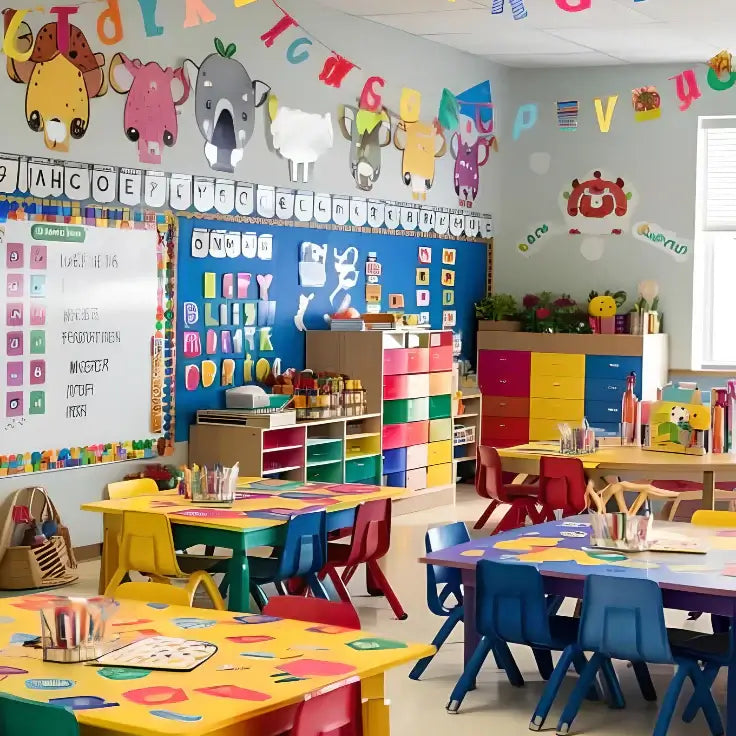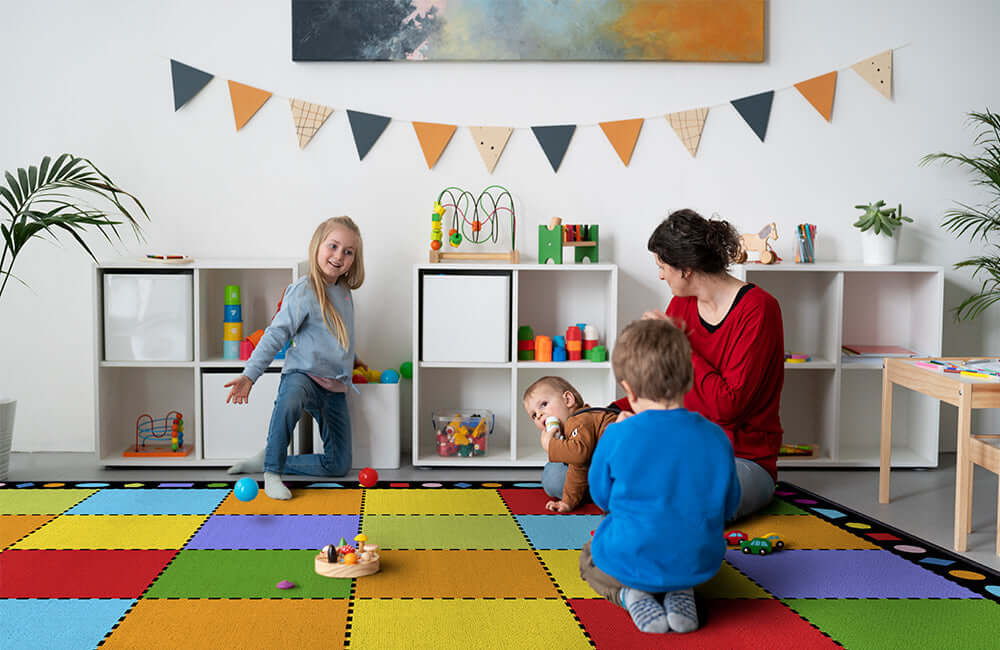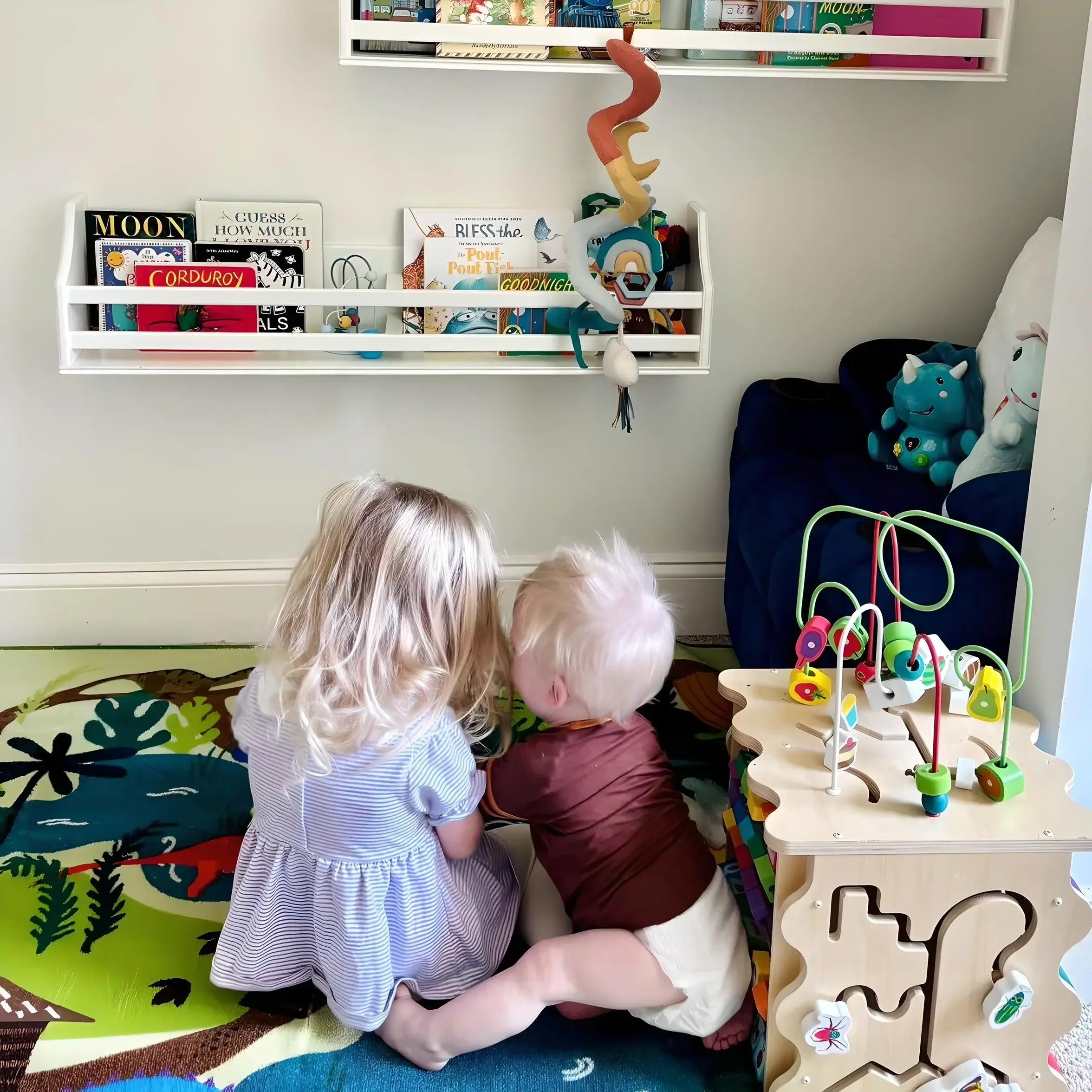Understanding Sensory Processing in Educational Settings
Sensory processing is the neurological process by which our nervous systems receive, organize, and respond to sensory information from our environment.
According to the American Occupational Therapy Association, sensory processing differences affect 5-16% of children, though many more students benefit from sensory-supportive environments even without formal diagnoses.
When students' sensory systems are overwhelmed or under-stimulated, their ability to focus, learn, and regulate emotions becomes compromised.
The classroom environment—including flooring, seating, lighting, and materials—directly impacts how well students can access their cognitive resources for learning rather than managing sensory input.
Sensory-friendly classroom materials recognize that students have diverse sensory preferences and needs.
Some students may be hypersensitive to certain textures, sounds, or visual stimuli, while others may seek intense sensory input to help organize their nervous systems.
Creating environments that accommodate this full spectrum of sensory needs benefits all learners.
The Foundation of Sensory-Friendly Design: Kids Rugs as Sensory Tools
Kids rugs serve as foundational elements in sensory-friendly classrooms because they provide consistent tactile input, visual organization, and spatial definition that supports diverse sensory processing styles.
Unlike traditional hard flooring that offers minimal sensory feedback, thoughtfully selected rugs can provide calming deep pressure, alerting texture input, or neutral surfaces that don't overwhelm sensitive systems.
Tactile Processing and Texture Considerations
The texture of classroom rugs significantly impacts students' tactile processing and overall comfort in learning spaces.
Students with tactile hypersensitivity may find rough, scratchy, or highly textured surfaces distressing and distracting, while students with tactile hyposensitivity may seek out interesting textures for sensory input and regulation.
Research from UC Davis MIND Institute demonstrates that sensory processing challenges can significantly impact learning and behavior, making environmental accommodations crucial for academic success.
Natural fiber rugs with consistent, gentle textures often work well for hypersensitive students, providing comfort without overwhelming their systems.
For students seeking sensory input, rugs with varied textures, raised patterns, or interesting weaves can provide the tactile stimulation they need for optimal arousal and attention.
Visual Processing and Color Psychology
Color choices in classroom rugs affect visual processing, attention regulation, and emotional responses in all students. Bright, high-contrast colors may be energizing for some students while overwhelming others.
Understanding color psychology and individual student needs helps educators select rug colors that support rather than hinder learning.
Calming colors like soft blues, gentle greens, and pastel classroom rugs tend to support regulation and focus for many students.
However, some students with attention challenges may benefit from more alerting colors like those found in colorful classroom rugs that help maintain engagement.
The key is balancing individual needs with overall classroom atmosphere.
Proprioceptive Input and Body Awareness Through Floor Surfaces
Proprioception—the sense of body position and movement—plays a crucial role in attention, behavior regulation, and learning readiness.
Many students, particularly those with sensory processing differences, ADHD, or autism spectrum disorders, benefit from proprioceptive input that helps them understand where their bodies are in space.
Deep Pressure and Calming Input
Thick, cushioned rugs such as round classroom rugs provide proprioceptive input when students sit, lie, or apply pressure to the surface.
This deep pressure input is often calming and organizing for students who feel overwhelmed or dysregulated.
Students may naturally seek this input by pressing into the rug with their hands, lying flat against the surface, or sitting with extra pressure.
According to Temple Grandin's research on sensory processing and deep pressure, this type of input can significantly reduce anxiety and improve focus in individuals with sensory processing differences.
Movement Integration and Fidgeting Opportunities
Traditional classroom expectations that require prolonged sitting can be challenging for many students, particularly those with ADHD or sensory processing differences.
Textured rugs provide opportunities for appropriate movement and fidgeting that can help students maintain attention without disrupting instruction.
Students can trace patterns with their fingers or toes, shift positions on interesting textures, or engage in subtle movement that supports their sensory needs while remaining engaged with learning activities.
Auditory Considerations in Sensory-Friendly Spaces
While rugs are primarily tactile and visual materials, they also impact the auditory environment of classrooms by providing sound absorption and reducing echo that can be overwhelming for students with auditory processing sensitivities.
Sound Dampening and Acoustic Comfort
Hard classroom floors can create echoing environments that make it difficult for students with auditory processing challenges to distinguish important sounds like teacher instructions from background noise.
Rugs help absorb sound and create more comfortable acoustic environments for all students.
Research from the Acoustical Society of America shows that classroom acoustics significantly impact learning, particularly for students with hearing differences, auditory processing disorders, or attention challenges.
Reducing Distracting Sounds
Chair legs scraping against hard floors, students walking across the room, and dropped materials create sudden sounds that can be startling or distracting for sensitive students.
Rugs help muffle these incidental sounds, creating calmer auditory environments that support focus and regulation.
Explore our collection of acoustic classroom rugs designed to support both sensory and auditory needs.
Material Safety and Sensory Considerations
Sensory-friendly classroom materials must balance sensory support with safety, durability, and maintenance requirements.
Understanding how different materials affect students with various sensitivities helps educators make informed choices about classroom furnishings.
Chemical Sensitivities and Material Composition
Some students have chemical sensitivities that can be triggered by synthetic materials, dyes, or treatments used in classroom rugs.
Natural fiber options or low-emission synthetic materials may be necessary for students with multiple chemical sensitivities or respiratory conditions.
The Environmental Protection Agency provides guidelines for creating healthy indoor environments in schools, emphasizing the importance of material selection in supporting student health and learning.
Maintenance and Hygiene for Sensitive Students
Students with sensory processing differences may be particularly sensitive to odors from cleaning products or materials that haven't been properly maintained.
Regular cleaning with gentle, unscented products helps maintain sensory-friendly environments that don't trigger defensive responses in sensitive students.
Some students may also have concerns about cleanliness that affect their willingness to sit or lie on floor surfaces.
Providing individual mats or small classroom rugs can address these concerns while maintaining sensory benefits.
Creating Sensory Zones with Strategic Material Placement
Effective sensory-friendly classrooms often include designated areas for different types of sensory input and regulation needs.
Kids rugs can help define these zones while providing the specific sensory properties each area requires.
Calm-Down and Regulation Areas
Designated calm-down spaces require materials that provide comfort and regulation without overstimulation.
Soft, neutral-colored rugs with gentle textures work well for these areas, providing a clear visual and tactile signal that this space is designed for emotional and sensory regulation.
These spaces work best when they feel separate from main classroom activity while remaining easily accessible and non-punitive.
The rug choice communicates the purpose of the space and helps students understand how to use it effectively.
Alert and Focus Zones
Some students need more stimulating sensory input to maintain optimal arousal levels for learning.
Designated areas with more textured or visually engaging rugs can provide appropriate sensory input for students who need alerting rather than calming sensory experiences.
These zones might include reading rugs with interesting patterns, varied textures, or slightly more stimulating colors that help hyposensitive students maintain engagement and attention.
Flexible Multi-Sensory Spaces
The most effective sensory-friendly classrooms maintain flexibility to accommodate changing student needs throughout the day.
Modular rug systems or easily moveable materials allow educators to reconfigure spaces based on activities, student needs, or specific sensory goals.
Supporting Different Sensory Profiles
Understanding that students have different sensory profiles helps educators select materials that support rather than overwhelm diverse nervous systems.
No single material choice will work for all students, making variety and options essential components of sensory-friendly design.
Hypersensitive Students and Gentle Materials
Students who are hypersensitive to sensory input often perform best with materials that provide comfort without overwhelming their systems.
Smooth, soft textures in neutral colors tend to be well-tolerated by students with tactile or visual hypersensitivities.
These students may also benefit from having predictable, consistent sensory experiences rather than surprising or varying input that could trigger defensive responses.
Hyposensitive Students and Stimulating Input
Students who are hyposensitive to sensory input may seek intense experiences to help regulate their nervous systems.
These students often benefit from rugs with varied textures, interesting patterns, or surfaces that provide significant sensory feedback.
Providing multiple texture options allows hyposensitive students to seek the input they need while giving hypersensitive students alternatives that feel safe and comfortable.
Mixed Sensory Profiles and Individual Accommodation
Many students have mixed sensory profiles, being hypersensitive in some areas while hyposensitive in others.
These complex sensory needs require flexible environments with multiple options rather than one-size-fits-all solutions.
Individual accommodation may involve allowing students to choose their seating surface, providing personal sensory tools, or creating multiple options within the same learning space.
Integration with Other Sensory-Friendly Materials
Kids rugs work most effectively when integrated with other sensory-friendly classroom materials that support diverse learning needs.
Creating comprehensive sensory environments requires considering how different materials work together to support student success.
Flexible Seating Options
Combining sensory-friendly rugs with varied seating options—stability balls, wobble cushions, standing desks, or floor seating—provides students with choices about how to position their bodies for optimal learning.
This combination addresses both tactile and proprioceptive needs while supporting different attention and focus styles.
Research from Mayo Clinic demonstrates that movement and sensory input can significantly improve attention and learning in students with ADHD and other attention challenges.
Lighting and Visual Environment
The visual environment, including lighting choices, wall colors, and visual organization, interacts with rug selections to create overall sensory experiences.
Harsh fluorescent lighting combined with bright, high-contrast rugs may be overwhelming, while soft lighting with neutral rug tones creates calming environments.
Sound Management Tools
Combining acoustic-friendly rugs with other sound management strategies—like noise-canceling headphones, quiet zones, or background music—creates comprehensive auditory environments that support diverse processing needs.
For complete environmental design solutions, explore our comprehensive classroom design guide.
Assessment and Implementation Strategies
Creating truly sensory-friendly environments requires ongoing assessment of student needs and willingness to adjust materials based on observed responses.
What works for one group of students may not work for another, making flexibility and responsiveness essential.
Observing Student Responses
Pay attention to how students naturally interact with different rug materials and textures. Do they seek out certain areas?
Avoid specific textures? Show signs of comfort or distress with particular materials? These observations provide valuable information about sensory preferences and needs.
Student Input and Choice
When appropriate, involve students in selecting or arranging sensory materials.
Students often have insight into their own sensory needs and can provide valuable feedback about what helps them feel comfortable and ready to learn.
Collaboration with Specialists
Occupational therapists, special education professionals, and other specialists can provide valuable insights about specific sensory needs and material recommendations.
Collaborating with these team members ensures that material choices align with individual student goals and therapeutic recommendations.
The Science Behind Sensory-Friendly Learning
Understanding the neurological basis for sensory-friendly design helps educators and administrators recognize that these accommodations are based on brain science rather than preferences or convenience.
When students' sensory systems are supported, their cognitive resources become available for learning rather than managing overwhelming input.
Neuroplasticity and Environmental Impact
Research from Harvard Medical School demonstrates that environmental factors can actually influence brain development and function.
Sensory-friendly environments don't just make students more comfortable—they can support actual changes in neural processing and learning capacity.
Stress Response and Learning
When students' sensory systems are overwhelmed, their stress response systems activate, making learning and memory formation more difficult.
Sensory-friendly materials help keep students in optimal arousal states for learning by preventing sensory overload and supporting regulation.
The National Institute of Mental Health explains how chronic stress affects learning and development, making sensory support a crucial component of academic success.
Long-Term Benefits of Sensory-Friendly Design
Investing in sensory-friendly classroom materials provides benefits that extend far beyond immediate comfort and regulation.
Students who learn in sensory-supportive environments develop better self-awareness, self-advocacy skills, and positive associations with learning that support lifelong success.
Self-Regulation Skill Development
When students have access to appropriate sensory tools and environments, they learn to recognize their own needs and take appropriate action to maintain optimal learning states.
These self-regulation skills transfer to other environments and support independence throughout life.
Reduced Behavioral Challenges
Many behavioral challenges in classrooms stem from unmet sensory needs or overwhelming environments.
When sensory needs are proactively addressed through environmental design, behavioral incidents often decrease significantly, creating more positive learning environments for all students.
Academic Achievement and Engagement
Students who feel comfortable and regulated in their learning environments are better able to engage with academic content, participate in classroom activities, and develop positive relationships with peers and teachers.
This increased engagement directly supports academic achievement and school success.
Building Inclusive Communities Through Sensory Awareness
Creating sensory-friendly classrooms benefits all students by building awareness of individual differences and promoting inclusive attitudes.
When classrooms obviously accommodate diverse sensory needs, all students learn that differences are normal and valuable rather than problems to be hidden or overcome.
Peer Understanding and Acceptance
When sensory accommodations are integrated naturally into classroom environments, neurotypical students develop understanding and empathy for sensory differences.
This exposure builds inclusive attitudes that extend beyond school settings.
Teacher Confidence and Effectiveness
Educators who understand sensory processing and have access to appropriate materials report feeling more confident and effective in supporting diverse learners.
This professional growth benefits entire school communities by building capacity for inclusive education.
Creating sensory-friendly learning environments through thoughtful material selection represents an investment in student success, teacher effectiveness, and inclusive education.
When we design classrooms that work for students with diverse sensory needs, we create better learning environments for everyone while building communities that celebrate rather than merely tolerate human differences.




Leave a comment
This site is protected by hCaptcha and the hCaptcha Privacy Policy and Terms of Service apply.